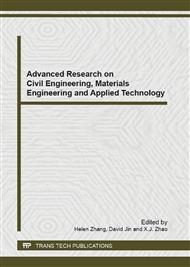[1]
Yuan Yi-fan and Sun Bo-tao. (2008). General introduction of engineering damage of Wenchuan Ms 8. 0 earthquake. Jouranl of Earthquake Engineering and Engineering Vibration 28: Supplement, 74-86.
Google Scholar
[2]
Yu Yong-qing, Li Guang-fan and Li Peng et al. ( 2008). Investigation and analysis of electric equipment damage in Sichuan power grid caused by Wenchuan earthquake. Power System Technology 32: 11, 1-6.
Google Scholar
[3]
Zhou Shi-ping. ( 2008). Transformer damage analysis in the 5. 12 Wenchuan earthquake. Hubei Electric Power, 32: 4, 1-4.
Google Scholar
[4]
Gan Yan, Chen Peng-yun and Wang Chengzhi. (2009). Study on the seismic effects on the transformer. Middle China Electric Power 22: 3, 14-17.
Google Scholar
[5]
Xie Qiang, Zhu Rui-yuan and Qu Wenjun. (2011). Analysis on seismic failure mechanism of 500 kV high-power transformer during Wenchuan earthquake. Power System Technology 35: 3, 221-226.
Google Scholar
[6]
Cao Mei-gen, Zhou Fu-lin and Tan Ping et al. (2011). Shaking table test on seismic performance of large power transformer with bushings. Journal of Vibration and Shock 30: 11, 122-129.
Google Scholar
[7]
Cao Mei-gen. (2011). Research on seismic performance and Isolation mitigation techniques of large power transformer and bushing system. Guangzhou University.
Google Scholar
[8]
Cao Mei-gen, Fan Rong-quan and Li Shi-Ping et al. (2011). Design and application of seismic isolation system of large power transformer and bushings system. Power System Technology 35: 12, 130-135.
Google Scholar
[9]
Zhou Fu-lin. (1997) . Engineering structural vibration control. Beijing Earthquake Press.
Google Scholar
[10]
Xie Qiang and Wang Ya-fei. (2010). Seismic response analysis of substation equipment interconnected by flexible bus. Proceedings of the CSEE 30: 34, 86-92.
Google Scholar
[11]
Xie Qiang and Wang Ya-fei. (2011). Shake-table test on earthquake simulation of substation equipment interconnected by flexible bus. Proceedings of the CSEE 31: 44, 112-118.
Google Scholar
[12]
Huang Yong-lin. (2006). Equipment isolation design. Beijing Earthquake Press.
Google Scholar
[13]
IEEE. (2005). Recommended practice for seismic design of substations. Institute of Electrical and Electronics Engineers.
Google Scholar
[14]
Murota N, Feng M Q and Liu G Y. (2006). Earthquake simulator testing of base-isolated power transformers. IEEE Transactions on Power Delivery 21: 3, 1291-1299.
DOI: 10.1109/tpwrd.2006.874586
Google Scholar
[15]
Murota N, Feng M Q, Liu G Y. (2006). Experimental and analytical studies of base isolation systems for seismic protection of power transformers. Buffalo Multidisciplinary Center for Earthquake Engineering Research.
Google Scholar
[16]
Saadeghvaziri M A, Feizi B and Kempner L et al. (2010). On seismic response of substation equipment and application of base isolation to transformers. IEEE Transactions on Power Delivery 25: 1, 177-186.
DOI: 10.1109/tpwrd.2009.2033971
Google Scholar
[17]
Tang You-gang. (2002). Adavance structural dynamics. Tianjin University Press.
Google Scholar
[18]
Clough R W and Penzien J. (1993). Dynamics of structures(2nd). Singapore International Editions.
Google Scholar
[19]
Liu Ji-yu, Luo Jun-xiong and Lu Rui-fan et al. (2001). Experiment and system identification of base-isolated electric power transformers. Earthquake Engineering and Engineering Viabration 21: 4, 109-116.
Google Scholar
[20]
Mai Jing-bo. (2006). Research of composite isolation system. Guangzhou University.
Google Scholar
[21]
Howard Matt and André Filiatrault. (2004) Seismic qualification requirements for transformer buishings. PEER SSRP – 2003/12, University of California, San Diego, La Jolla, CA.
Google Scholar
[22]
K. Kagemamori and H. yamaguchi et al. (1996). Impact of the great hanshin earthquake on substation equipment and possible countermeasures. CIGRE symposium.
Google Scholar
[23]
GB50260-96. (1996). Code for design of seismic of electrical installations. China Planning Press.
Google Scholar


